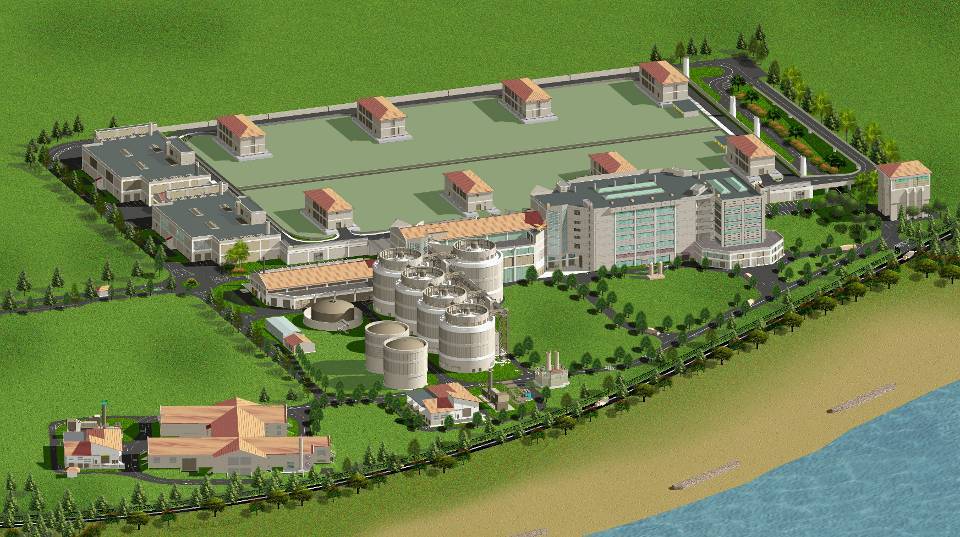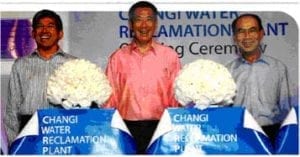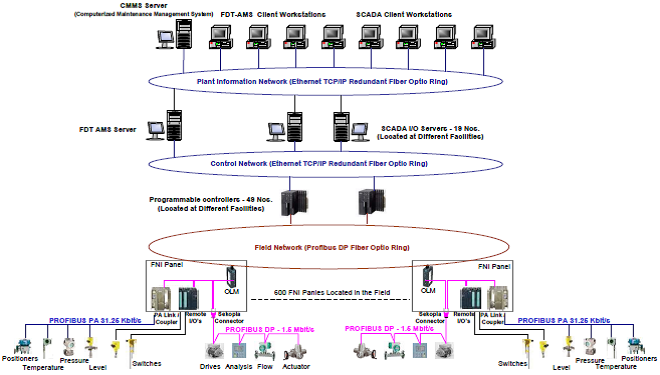
The largest wastewater treatment plant in the world relies on FDT Technology for device integration.
 Singapore is no stranger to showcase projects. Be it a spectacular skyscraper or a gigantic Ferris wheel, Singapore is known for its bold and daring undertakings. The latest flagship project in the smallest tiger economy in Southeast Asia focuses on the area of water, waste water, environmental protection and sustainability. The summer of this year heralded the opening of the Changi Water Reclamation Plant, a waste water reclamation plant that boasts a unique, trendsetting concept. The technology installed is cutting-edge, with an FDT-based asset management system overseeing 10,000 instruments of all makes and kinds in a consistent, uniform and extremely effective manner.
Singapore is no stranger to showcase projects. Be it a spectacular skyscraper or a gigantic Ferris wheel, Singapore is known for its bold and daring undertakings. The latest flagship project in the smallest tiger economy in Southeast Asia focuses on the area of water, waste water, environmental protection and sustainability. The summer of this year heralded the opening of the Changi Water Reclamation Plant, a waste water reclamation plant that boasts a unique, trendsetting concept. The technology installed is cutting-edge, with an FDT-based asset management system overseeing 10,000 instruments of all makes and kinds in a consistent, uniform and extremely effective manner.
The “Changi Water Reclamation Plant (CWRP)” is the world’s largest wastewater treatment plant and the centerpiece of Singapore’s project to construct a deep tunnel sewerage system (DTSS) – a scheme unparalleled anywhere in the world. On June 23, 2009, the wastewater treatment plant of the national water agency, PUB, was officially opened (see Figure 1). The plant itself was constructed for the government by the international project consultant CH2M Hill Singapore. Located close to the airport, the completed, compact, covered plant, which deploys the latest in cutting-edge technology, is designed for a capacity of 2.4 million cubic meters per day – equivalent to the volume of 960 Olympic swimming pools. What is revolutionary about this plant is that an innovative concept of water treatment means that every single drop of water leaving the CWRP can be reused. High-tech processes controlled by the most modern automation engineering technology make this possible.
Architecture of the distributed control system
All the information from field PA instruments like pressure transmitters, temperature transmitters, level transmitters and positioners is routed to the 600 field network interface panels (FNI) via PA links and couplers, which can cover distances of up to 2,600 meters. Drives, analytical instruments, flowmeters and actuators are connected via Profibus DP via Sekopia connectors and OLMs. From the fieldbus network, information is transmitted to the 49Nos of Programmable Logic Controllers which are located in air- conditioned rooms in various parts of the plant. These controllers, which are the heart of the plant, provide all process control and communicate via the control network, Ethernet TCP/IP and a redundant fiber optic ring with the Field Device Tool server (FDT) for asset management and SCADA I/O servers in various systems.
Field devices and fieldbus network
The following instruments are at work in the plant:
- 500 magnetic flowmeters
- 400 thermal mass flowmeters
- 400 pressure/DP/submersile transmitters
- 140 radar and ultrasonic transmitters
- 50 optical TSS transmitters
- 40 dissolved oxygen analyzers
- 100 temperature transmitters
- 5000 electric actuators
- 400 pneumatic actuators
- 400 variable speed drives
- 100 motor control centers
- 600 switches, samplers, and approximately 100 PROFIBUS masters

It was the project consultant’s aim to use FDT based Asset Monitoring Management to ease the daily routine maintenance work. “We chose to use FDT technology as an open solution in which the operator is not restricted to any specific manufacturer.” explained Chief Resident Engineer (MCS) Jane Goh. The only condition was that the vendor had to make a device type manager (DTM) – a device driver for the FDT technology – available for every device. As a result, instruments from 15 different manufacturers work in unison in the multivendor plant, including products from ABB, AUMA, Emerson Process Management, Endress+Hauser, FCI Fluid Components International, ProSoft, rotork, Schneider Electric, Siemens, Smar, Vega, and Yokogawa.
The sewage treatment plant in Changi is one of the biggest Profibus installations in the world. 7,000 Profibus DP and 2,500 Profibus PA instruments are installed in the plant. 6,000 signals have been cabled discretely via Profibus DP remote I/Os. To make this possible, technicians laid a total of 200,000 m of copper cable and 100,000 m of fiber optic cable for the Profibus DP network. Further 60,000 m are used in the Profibus PA network – impressive figures. 600 operating panels located in different plants are available to staff over the entire network.
Challenges for asset management
The question of asset management presented the decision-makers with serious challenges, as every field device manufacturer makes different tools available for calibration. For end users this means that they have to be familiar with a plethora of tools that are expensive to maintain and operate.
Furthermore, no real-time information is available to service staff for maintenance and repair management. The situation is further compounded when different systems or communication protocols operate in parallel.
The solution
FDT ultimately presented a solution for integrated and efficient asset management. The open and fieldbus-independent concept presents unforeseen opportunities. This is made possible by advanced functions that are stored as active software components in the DTMs.
The FDT standard forms the basis to integrated, information-oriented solutions that cover every level of the automation pyramid – from field devices and the MES level to the ERP systems of a business. FDT allows openness and interoperability of field devices and systems for engineering, diagnosis and asset management tasks alike. Standardized fieldbus protocols guarantee communication between intelligent field devices and the higher-order systems.
FDT
FDT defines the interface between the vendor of the field devices and the engineering tool of the distributed control system, but does not affect the field devices themselves. The technology enjoys a high degree of acceptance in many industry sectors.
The open technology allows the integration of a wide range of products, such as sensors, valves, drives, low-voltage switch gears etc. The product manufacturers are responsible for the information provided by the field devices via the DTM. The cross-vendor solution is supported by many leading manufacturers of instrumentation and control systems.
Device Type Manager (DTM)
The device-specific software component is known as the DTM. It can be integrated in an engineering tool or a system environment. The DTM maps the configuration, diagnostics and other functions of the device. The software knows the possibilities and limits of the device and contains all the dialogs with the user as well as all the graphic displays. One further advantage is that device-specific documentation can be created per DTM.
Asset management requirements
Given the magnitude and complexity of the project, the FDT asset management system had to meet a number of specific requirements:
- Client/Server architecture
- Support for TCP/IP, Profibus & HART protocols
- Project structure (network/plant), compliant with ISA S88 specification
- Comprehensive user & session management
- Activity logging and reporting
- The data captured must be transmitted online to “CMMS” for preparation and planning
- Import/export function for new projects
- Instrument search function (network & plant view)
Integrated information
DNR Process Solutions, a supplier of tailor-made automation solutions in Singapore, provided the solution. The company was actively supported by ifak system in Magdeburg, Germany. The two partners worked together to develop the Field Intelligence (FI) FDT-based asset management system for the wastewater treatment plant in Singapore, which has to meet incredibly strict requirements and objectives. For the first time ever, the software has a client/server architecture. In this way, up to 10 users can simultaneously access the desired information from any location via the Internet. The system facilitates remote configuration, diagnostics and supervision of all devices that are linked to open communication protocols such as Profibus or HART. The data can be saved in a central maintenance management system. On the basis of operational findings with regard to the availability and utilization of the individual assets in real time, the system helps boost the efficiency of the plant. The asset management system successfully overcame the challenges and passed tests with flying colors. In the Changi Water Treatment Plant, the largest wastewater treatment plant in the world, it continuously, uniformly and cost-effectively manages some 10,000 field devices from a wide range of manufacturers. The key technology of the solution is FDT – a technology that offers real added value.
This article is based on a presentation made by Jane Goh, former chief engineer (Monitoring and Control System) at CWRP (Changi Water Reclamation Plant) in Singapore at an event of the FDT Group.
The mega-project at a glance
- It took 15 years from the initial idea to commissioning in June 2009.
- Capacity: 800,000 cubic meters of wastewater per day in the 1st development stage. When fully constructed, the plant will be able to handle 2.4 million cubic meters per day.
- One pump station in the new plant is as high as a 25-story building.
- Project scope: CWRP in Changi $3.65 billion
- Over 350 domestic and international suppliers.
- Multi-award-winning environmentally friendly, sustainable concept. For the first time ever, a water treatment plant has been installed on the roof of a sewage treatment plant. Only one third the footprint of conventional plants.
- By gradually dismantling the three existing sewage treatment plants, densely populated Singapore gains valuable land for building, covering a space equivalent to 190 football pitches.
- Optimum efficiency thanks to size and centralization.
- Critical part of a sustainable development.
- Together with the existing plants, the new water treatment plant safeguards a third of Singapore’s drinking water supply. One more step towards self-sufficiency and less dependency on water supply from neighbors.